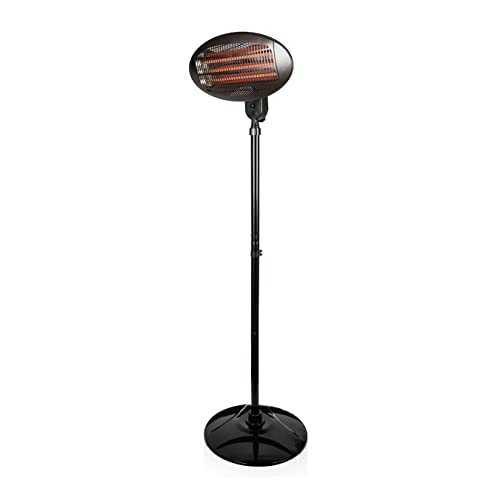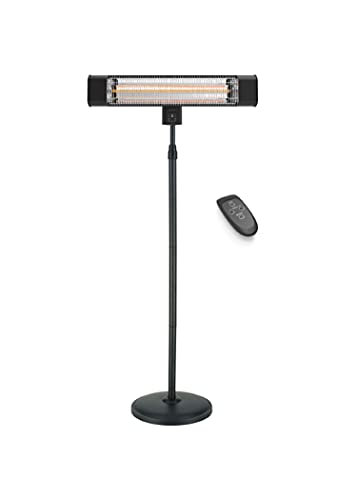Guide To Small Electric Patio Heater: The Intermediate Guide For Small…
페이지 정보

본문
 Enjoy Your Patio Even When the Weather Turns Cool With a Small Electric Patio Heater
Enjoy Your Patio Even When the Weather Turns Cool With a Small Electric Patio HeaterElectric patio heaters are plug-and- go, unlike gas patio heaters, which require the connection of a propane tank and professional installation in an existing gas line. They can be connected to an outlet for power in the outdoor and controlled via remote or by the use of a timer.
Depending on the model depending on the model, these heaters can produce heat up to 12 feet and be easily pushed around on wheels that allow them to go over bumps and other obstacles in your backyard. They also don't release carbon monoxide which is a problem with some gas models.
Heat Output
Many people love sitting on their patios and in their cozy backyard corners. However these areas can get cold as the temperature drops. A Small Electric Patio Heater (Hikvisiondb.Webcam) can help warm up these spaces and allow you to extend your outdoor time well into the evening, even after the sun sets.
The most efficient electric heater for outdoor patio patio heaters have the capacity to produce a lot of heat. You can control the amount of warmth they generate by adjusting their power settings. You can keep your patio warm without increasing the cost of energy. In addition, you should consider a model that has lower watts, as this will reduce the amount of energy it consumes.
In terms of heating effectiveness the patio heater's BTU rating is the most crucial factor to consider. The higher the BTU is, the bigger the area that it can heat. A heater with a BTU of 40,000, for instance can warm a patio that is up to 1,000 square foot.
Another factor that affects the heat output of the patio heater is whether it's covered or not. Covered patios will minimize loss of heat and keep the warmth generated by the heater for longer. On the other hand, exposed patios will lessen the heat they generate as it rises into the air. Additionally, the type of furniture you choose to use can affect the effectiveness of a patio heater will be.
Glass and metal tables for instance reflect heat better than plastic or wooden tables. Although the two materials are less expensive, they won't warm up your patio in the same way.
It's important to remember that based on the fuel source your patio heater may need to be placed in a well ventilated space. Carbon monoxide is released by propane and natural gas heaters. This can be dangerous in enclosed spaces. According the manufacturer they are best used outdoors or in a space that is well ventilated. Electric heaters, on the other hand don't emit any harmful emissions and are safe to use in restricted areas.
Safety Features
Patio heaters can provide an inviting touch to the outdoors, but they're not without dangers. Propane heaters and natural gas heaters can emit dangerous carbon dioxide if used correctly. Make sure you choose models with safety features such as tip-over switches or protection against overheating. To ensure proper use it is also recommended to read the instructions and safety tips from the manufacturer.
You'll also want to be certain that you are performing regular maintenance on your heater. Check that all connections are secure, and verify that the gas lines aren't leaky. If you use an electric model, you need to keep combustible materials such as paper or fabric away from the heating element, since the heat that is released could ignite if they come in contact with these items. Standing heaters are susceptible to being thrown over, so make sure they're placed on flat surfaces and away from anything that could fall on them.
Many propane and natural-gas heaters have flame failure devices, which cut off the supply of fuel in the event of a fire out. Some heaters have an automatic shut-off for tip-overs that detects when it tilts or moves away from an even surface. While these features can reduce the chance of injury, you must remain cautious about where you put them and ensure that you never leave them unattended while they're operating.
Another security feature to consider is a carbon monoxide detector. This is a must-have feature to any home, but is especially important when using gas patio heaters. This device alerts you to the dangers of carbon monoxide, which can quickly build up in small spaces and cause death.
If you're looking for an electric heater be sure to choose one that has remote control and programmable timer to allow you to set the ideal amount of warmth to your space. These options give you the flexibility to control your heater easily while still enjoying an outdoor lifestyle. For homes with a design-oriented focus, look for models that can be hung to the ceiling or integrated into the wall. This will save space. These units will be more subtle than larger models which makes them perfect for smaller areas which don't want to sacrifice style.
Power Options
There are several options available when it comes to the energy source of your new patio heater. Whether you opt for an electric or gas powered model depends on the size of your patio, existing energy sources and personal preferences.
Generally speaking electric garden patio heater models are generally more cost effective and more user-friendly than gas models. They can be connected to regular electrical outlets and switched on with the flick of a switch or the push of a button. A lot of these heaters come with different heat settings, allowing you to decide how much heat your room receives. These heaters are ideal for areas that are prone to winds. They won't blow out like gas heaters.
Gas patio heaters are renowned for their high heating capacity and are capable of effectively warming areas of up to 215 square feet. Depending on the type gas used, they can be connected to propane or natural gas lines, or operated by portable cylinders that can be filled with propane or wood pellets depending on the need. Unlike electric models, gas heaters require at least 25 percent of the area surrounding the burner for safe operation and are more likely to release carbon monoxide when not properly ventilated.
The Btu (British Thermal Units) is the measurement unit used to measure the amount of heat produced by the gas patio heater. Consider the size of your outdoor space when selecting a model. A larger Btu rating will provide a greater heating coverage. For example, for a 2,000 square foot patio heater electric infrared, you would need a heater for your patio that has a Btu rating of 40, 000.
While there are advantages when you choose a propane-powered patio heater it's important to remember that you'll need to regularly purchase and replace fuel for this type of heater. According to Thomas Bonfiglio, CEO and the founder of Triple T Hospitality, a model that is 40,000 Btu will consume approximately two pounds of propane each hour it's on full power.
You should consider a pellet patio heater if you want a more environmentally friendly option. These models operate on compressed wood pellets, and are generally more affordable than other gas patio heaters. They're also less prone to emissions and burn more efficiently than other kinds of patio heaters that result in less waste and less pollution. They are available in various styles, including freestanding units and wall-mounted models that can be hung on ceilings or walls.
Overall
Relax on Your Patio Even if the weather turns cool
A high-quality patio heater lets you take advantage of your outdoor space into the night and across all seasons. At Lowe's we have overhead, freestanding and commercial grade patio heaters to meet the needs of your business or home. We also have a range of heating accessories, such as switches and control systems that allow you to control the temperature and length of use of your heater.
The kind of patio heating you select will be determined by the size of your outdoor space as well as the power sources that are available at your office or at home. Electric models are the most simple to install since they plug into standard 120 volt outlets. Gas-powered patio heaters can be dangerous because they emit carbon monoxide. Electric models do not. Some of them can be controlled remotely, while others are timed. They also have multiple temperatures.
Patio heaters that are powered by propane and natural gas can provide heat as high as 215ft2. They require gas lines and should only be used in areas that are well ventilated since they can release carbon monoxide if left unattended. They are a great choice for large outdoor areas that you want to keep warm throughout the year.
 For smaller outdoor living spaces, a small standing patio heater like our top pick is the ideal. This model comes with a remote and has an LED fire display which adds a decorative touch. It also has two heating options (750W and 1500W) to meet your various heating needs. It utilizes far-infrared technology which enhances the metabolism and circulation of blood while also providing warmth. It's ETL-approved and has a waterproof design that makes it ideal for courtyards, balconies garages, and patios. It's simple to set up and can be operated manually or by a built-in timer. The heater is automatically turned off by the built-in sensor when the temperature rises too high.
For smaller outdoor living spaces, a small standing patio heater like our top pick is the ideal. This model comes with a remote and has an LED fire display which adds a decorative touch. It also has two heating options (750W and 1500W) to meet your various heating needs. It utilizes far-infrared technology which enhances the metabolism and circulation of blood while also providing warmth. It's ETL-approved and has a waterproof design that makes it ideal for courtyards, balconies garages, and patios. It's simple to set up and can be operated manually or by a built-in timer. The heater is automatically turned off by the built-in sensor when the temperature rises too high.- 이전글10 Tell-Tale Warning Signs You Should Know To Get A New Gas Safety Certificate Price 24.12.13
- 다음글The 3 Biggest Disasters In Non Asbestos Causes Of Mesothelioma History 24.12.13
댓글목록
등록된 댓글이 없습니다.

